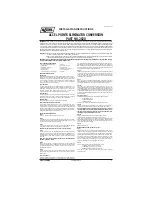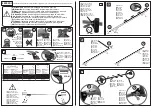
WARNINGS
Batteries contain sulfuric acid which
can burn skin, eyes and clothing, if
contacted.
Do not attempt to push-start your
automatic transmission vehicle. Automatic
transmissions do not have push-start
capability. Attempting to push-start a
vehicle with an automatic transmission
may cause transmission damage.
Preparing Your Vehicle
Note:
Use only a 12-volt supply to start your
vehicle.
Note:
Do not disconnect the battery of the
disabled vehicle as this could damage the
vehicle's electrical system.
1.
Park the booster vehicle close to the
hood of the disabled vehicle making
sure the two vehicles do not touch. Set
the parking brake on both vehicles and
stay clear of the engine cooling fan and
other moving parts.
2. Check all battery terminals and remove
any excessive corrosion before you
attach the battery cables. Ensure that
vent caps are tight and level.
3. Turn the heater fan on in both vehicles
to protect from any electrical surges.
Turn all other accessories off.
CN15-10881-AA
E146271
Refer to the label located above the
battery cover; the arrow on the label is
showing the correct location to make the
jump start connection.
Connecting the Jumper Cables
Note:
In the illustration, the vehicle on the
bottom is used to designate the assisting
(boosting) battery.
E149169
1.
Connect the positive (+) jumper cable
to the positive (+) terminal of the
discharged battery.
2. Connect the other end of the positive
(+) cable to the positive (+) terminal
of the assisting battery.
3. Connect the negative (-) cable to the
negative (-) terminal of the assisting
battery.
106
Ecosport (CBW) India, Vehicles Built From: 01-08-2015, enIND, Edition date: 08/2015
Roadside Emergencies
















































